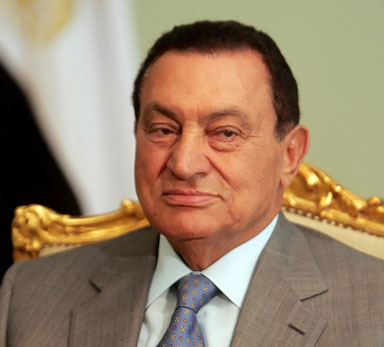Well, I don't have all the answers (who does?), but I can, however provide the basics.
The beginning

The beginning of Egypt's revolt does not start in Egypt at all, but rather in Tunisia.
Tunisia has been ruled by the same man, Ben Ali, and his regime for the past 22 years.
President Ali promises the people a democratic election, but they are unsatisfied. Ali eventually flees the country on January 14th. He is currently being sheltered in Saudi Arabia and is banned from participating in political activity concerning Tunisia.
Protests rage on as Prime Minister Mohamed Ghannouchi attempted to hold together a government comprised of President Ali's former cabinet and prominent protest leaders. But still the people were unsatisfied. On January 26th, a warrant for the arrest of President Ali and his family was issued and the government was stripped of almost all of Ali's former cabinet.
The people consider it a success.
http://www.ibtimes.com/articles/106613/20110129/wikileaks-helped-spark-tunisia-revolt-fp.htm
http://topics.nytimes.com/top/news/international/countriesandterritories/tunisia/index.html
Egypt
Protests in Egypt began on January 25th, 2011 caused by a mixture of the success in Tunisia and the Egyptian people's own anger over an oppressive leader.
The movement was coordinated in an unprecedented manner, via texting, Twitter, Facebook and other social networking sights which drew up huge crowds of mostly youth.
The Egyptian government does everything they can to crush the rebellion, including:
- Blocking internet service
- Blocking cell phone service
- banning protests
- using tear gas and rubber bullets
- imposing a nation-wide curfew
Listening to the Egyptian people
The key names in the Egyptian protests are:

- Egyptian President Hosni Mubarak (reigned for 30 years) The people are unhappy with him because, essentially he has "grown out of touch with the people", refused political involvement to the average citizen and fostered a corrupt government.
- The Brotherhood (the largest resistence force, the backbone of the protests and blanket name for the group opposed to Mubarak)
- Mohamed Elbaradei (a nobel laureate winner, the voice of The Brotherhood, speaks out against the regime government and is proposed the "new leader of Egypt" by The Brotherhood)
- Egyptian Vice-President Omar Suleiman (former head of military intelligence )
- Barack Obama and Hillary Clinton (involved because the United States largely funds the Egyptian military in exchange for Egypt being American allies. Egyptian authorities have been outspoken about their contempt for U.S. involvement)
Basic Timeline of protest events from January 25th to now:
Jan 25th: tens of thousands of Egyptian (mostly youth) citizens take to the streets, demanding the resignation of Egyptian president Hosni Mubarak.
Jan 26th: The Egyptian government attempts to crush the movement using above-mentioned tactics, but the people continue to protest.
Jan 28th: Protests continue, Mubarak orders his cabinet to resign, but refuses to resign himself. He names head of military intelligence Omar Suleiman as his Vice-President and Air Force chief Ahmed Shafik as prime minister. The military commands a great amount of respect from the people in Egypt, which is why Mubarak tried to bolster his popularity with two military officials.
Jan 29th: Protests continue, Mohamed Elbaradei demands that President Mubarak steps down immeadiately so that a new government can take over. Protests evolve into "open class warfare"
Jan 30th: The Muslim Brotherhood (Same as "The Brotherhood") announces support for Mohamed Elbaradei and his demands. Secretary of State Hillary Clinton publicly encourages democracy in Egypt.
Jan 31st: Protests continue, newly appointed Vice-President Suleiman opens a dialogue concerning political reform. The Egyptian economy begins to freeze as commerce, tourism and banking halt.
Feb 1st: Protests increase, President Mubarak announces he will not run for another term, but the people are unsatisfied, calling for his immediate resignation.
Feb 2nd: Pro-Government advocates begin to attack the protesters, fighting breaks out in Tahir Square (the main protesting grounds). The United States "breaks ties" with Mubarak (one of the U.S.'s strongest allies in the Middle East" and Obama parts with a call for Mubarek to resign.
Feb 3rd: Government supporters and protesters continue to fight. What's new? Nothing today.
Feb 4th: Calls contiinue to grow stronger for Mubarak to resign
Feb 5th: The US and the EU attempt to compromise with Vice-President Suleiman on a plan that wouldn't immeadiately remove Mubarak (the fear is that the country will collapse in chaos and hope for democracy will be lost upon Mubarak leaving the government)
Feb 6th: Most of the remaining Mubarak cabinet resigns, including Mubarak's son and heir to the throne. Mubarak remains the president of Egypt. Vice President Suleiman announces the transition to a post-Mubarak era has begun, setting up a reorganized government comprised of some Mubarek supporters and some opponents.
Feb 7th: The new government attempts to restore Egypt, repealing the curfew and announcing a salary hike
Feb 8th: The new government continues to announce reforms, but protesters refuse to accept anything less than Mubarak's resignation.
Essentially, that's where we are now. New government, angry citizens, same man in power.
Global Implications:
Feb 8th: The new government continues to announce reforms, but protesters refuse to accept anything less than Mubarak's resignation.
Essentially, that's where we are now. New government, angry citizens, same man in power.
Global Implications:
- Increased scrutiny of the United States and their willingness to monetarily back any government in the Middle East, regardless of the nature of government.
- Global fear of uprisings: China has increased filterings in their own country. Citizens cannot search anything related to Egypt for fear that it will inspire the Chinese to revolt.
- Less peace in the Middle East
- Increased economic instability for those who interacted with Egypt
Tomorrow, the Kennedy Center is hosting a panel of experts on Egypt who will be able to answer the tough questions. If you're interested, stop by 238 of the HRCB at noon.
Heather, that was so good! Seriously, I've been trying to follow what's going on and reading several articles a day and I learned more from your post. Thanks! I think we need an update now that Mubarak has resigned.
ReplyDelete